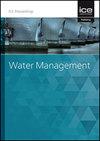静水盆地波浪型流的形成条件
IF 0.9
4区 工程技术
Q3 ENGINEERING, CIVIL
Proceedings of the Institution of Civil Engineers-Water Management
Pub Date : 2023-06-23
DOI:10.1680/jwama.22.00077
引用次数: 0
摘要
实验研究了最大和最小波型跳变的形成条件。共进行了110次波浪型跳变实验。对几种流量、超临界上游和亚临界下游水深、落差高度进行了试验。实验结果表明,波浪型跳变的有效参数是上游弗劳德数和相对落差。由于经典的水跃方程不足以定义波浪型流动的共轭深度,在现有文献中没有足够的实验数据的情况下,提出了定义最大和最小波浪型流动的共轭深度的经验方程,发现计算和测量的共轭深度之间的一致性很好。结果表明,最大跳波形成的上游弗劳德数下限不是恒定的,它取决于相对落差高度。此外,本研究的实验结果表明,最大和最小波浪型跃变的能量耗散比等于或大于经典水力跃变。因此,波浪型跃变可能更适合于有a跃变的降压盆地。本文章由计算机程序翻译,如有差异,请以英文原文为准。
Formation conditions of wave-type flows at stilling basins with a drop
In this study, formation conditions of maximum and minimum wave-type jumps are experimentally investigated. A total of 110 wave-type jump experiments are carried out. Experiments are conducted for several discharges, supercritical upstream and subcritical downstream water depths, and drop heights. According to the experimental results, the effective parameters on wave-type jumps are the upstream Froude number and the relative drop height. As the classical hydraulic jump equation is not sufficient to define conjugate depths of wave-type flow, empirical equations are presented for defining conjugate depths for both maximum and minimum wave- type jumps for which no sufficient experimental data is present in the available literature, and the agreement between the calculated and measured conjugate depths is found to be good. It is revealed that the value of the lower limit for the upstream Froude number is not constant for the formation of the maximum wave jump, and it depends on the relative drop height. Furthermore, experimental results of this study showed that energy dissipation ratios of maximum and minimum wave-type jumps are equal or larger than those of the classical hydraulic jumps. For this reason, wave-type jumps may be preferred at stilling basins with drops along with A-jumps.
求助全文
通过发布文献求助,成功后即可免费获取论文全文。
去求助
来源期刊
CiteScore
2.10
自引率
0.00%
发文量
28
审稿时长
6-12 weeks
期刊介绍:
Water Management publishes papers on all aspects of water treatment, water supply, river, wetland and catchment management, inland waterways and urban regeneration.
Topics covered: applied fluid dynamics and water (including supply, treatment and sewerage) and river engineering; together with the increasingly important fields of wetland and catchment management, groundwater and contaminated land, waterfront development and urban regeneration. The scope also covers hydroinformatics tools, risk and uncertainty methods, as well as environmental, social and economic issues relating to sustainable development.

 求助内容:
求助内容: 应助结果提醒方式:
应助结果提醒方式:


